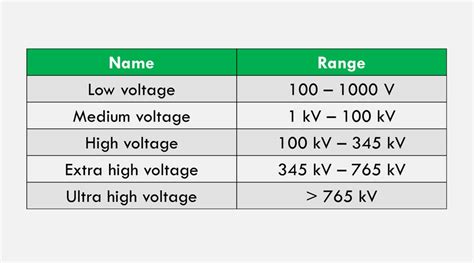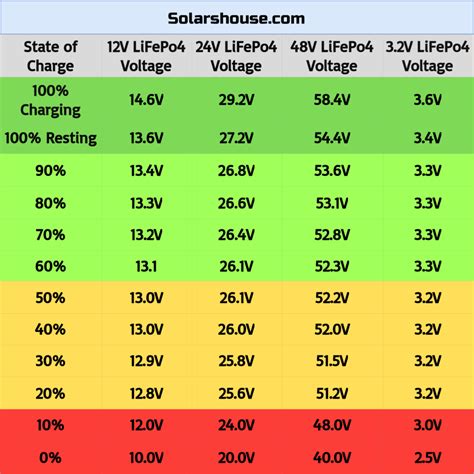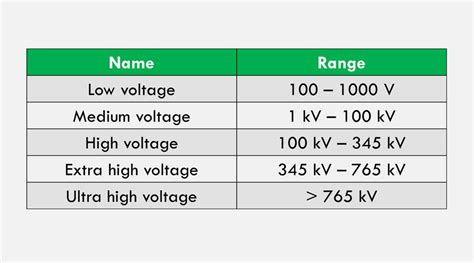lv vs mv | what is medium voltage range lv vs mv Different Types of Voltage Level: The different type of voltage notations is being used in a power system transmission and distribution. Let see the type of voltage. Rated Voltage. Nominal Voltage. Extra-low Voltage. Friday Night Lights study guide contains a biography of H.G. Bissinger, literature essays, quiz questions, major themes, characters, and a full summary and analysis. Best summary PDF, themes, and quotes.
0 · what is medium voltage range
1 · voltage range chart
2 · medium voltage vs high
3 · low voltage vs medium high
4 · low medium high voltage ranges
5 · difference between hv and Lv
6 · Lv mv hv voltage ranges
7 · Lv and mv electrical equipment
Buy Glynis Chocolate Loveseat: Sofas & Couches - Amazon.com FREE DELIVERY possible on eligible purchases
Different Types of Voltage Level: The different type of voltage notations is being used in a power system transmission and distribution. Let see the type of voltage. Rated Voltage. Nominal Voltage. Extra-low Voltage.High (HV), Extra- High (EHV) & Ultra-High Voltages (UHV) - 115,000 to 1,100,000 VAC. Medium Voltage (MV) - 2,400 to 69,000 VAC. Low Voltage (LV) - 240 to 600 VAC. Generac issued a .
In this blog, we present the definition of LV, MV and HV, the differences between voltages and their usage areas and more for you. What is the definition of Low Voltage, Medium Voltage and High Voltage?

Low Voltage (LV): up to 1000V. Medium Voltage (MV): between 1000 V and 45 kV. High Voltage (HV): between 45 kV and 230 kV. Extra High Voltage (EHV): from 230 kV and above. 3.2 Medium Voltage (MV): A class of nominal system voltages greater than 1,000V and less than 100kV. 3.3 High Voltage (HV): A class of nominal system voltages equal to or .
Voltage classifications typically include Low Voltage (LV), Medium Voltage (MV), and High Voltage (HV), each serving distinct purposes in power distribution and usage. This article .High Voltage - 35kV to 230 kV. Extra High Voltage - above 230 kV. In some situations, the term Ultra High Voltage is used to denote voltages above 800 kV. In addition, the IEC defines a .
what is medium voltage range
Medium voltage or MV: 1000 V to 45 kV; Low voltage or LV: up to 1000V; EHV is generated at a high level to account for losses encountered between generation and point of use. Low .

As such, as per the latest Regulations in vogue in India, there is no such classifications as LV, MV, HV & EHV. The National Electric Code (of India) 2011 (Reaffirmed in .Key Differences between LV and MV Cable. Voltage Rating: The primary difference between LV and MV cables is their voltage rating. LV cables have a voltage rating of less than 1 kV, while .
Different Types of Voltage Level: The different type of voltage notations is being used in a power system transmission and distribution. Let see the type of voltage. Rated Voltage. Nominal Voltage. Extra-low Voltage.
High (HV), Extra- High (EHV) & Ultra-High Voltages (UHV) - 115,000 to 1,100,000 VAC. Medium Voltage (MV) - 2,400 to 69,000 VAC. Low Voltage (LV) - 240 to 600 VAC. Generac issued a white paper titled Medium Voltage On-Site Generation Overview. The white paper compares NEC to ANSI Standards.
voltage range chart
In this blog, we present the definition of LV, MV and HV, the differences between voltages and their usage areas and more for you. What is the definition of Low Voltage, Medium Voltage and High Voltage?
Low Voltage (LV): up to 1000V. Medium Voltage (MV): between 1000 V and 45 kV. High Voltage (HV): between 45 kV and 230 kV. Extra High Voltage (EHV): from 230 kV and above. 3.2 Medium Voltage (MV): A class of nominal system voltages greater than 1,000V and less than 100kV. 3.3 High Voltage (HV): A class of nominal system voltages equal to or greater than 100kV and equal to or less than 230kV.
Voltage classifications typically include Low Voltage (LV), Medium Voltage (MV), and High Voltage (HV), each serving distinct purposes in power distribution and usage. This article explores these classifications and their applications, highlighting their differences and relevant products from Blue Jay.High Voltage - 35kV to 230 kV. Extra High Voltage - above 230 kV. In some situations, the term Ultra High Voltage is used to denote voltages above 800 kV. In addition, the IEC defines a voltage band known as the Extra Low Voltage with a AC voltage less than 70 V. See article here.
Medium voltage or MV: 1000 V to 45 kV; Low voltage or LV: up to 1000V; EHV is generated at a high level to account for losses encountered between generation and point of use. Low Voltage Classification As such, as per the latest Regulations in vogue in India, there is no such classifications as LV, MV, HV & EHV. The National Electric Code (of India) 2011 (Reaffirmed in 2016): Part 1 – Section 2-Low Voltage: The voltage which does not normally exceed 250 V .
Key Differences between LV and MV Cable. Voltage Rating: The primary difference between LV and MV cables is their voltage rating. LV cables have a voltage rating of less than 1 kV, while MV cables have a voltage rating between 1 kV and 33 kV.Different Types of Voltage Level: The different type of voltage notations is being used in a power system transmission and distribution. Let see the type of voltage. Rated Voltage. Nominal Voltage. Extra-low Voltage.High (HV), Extra- High (EHV) & Ultra-High Voltages (UHV) - 115,000 to 1,100,000 VAC. Medium Voltage (MV) - 2,400 to 69,000 VAC. Low Voltage (LV) - 240 to 600 VAC. Generac issued a white paper titled Medium Voltage On-Site Generation Overview. The white paper compares NEC to ANSI Standards.In this blog, we present the definition of LV, MV and HV, the differences between voltages and their usage areas and more for you. What is the definition of Low Voltage, Medium Voltage and High Voltage?
medium voltage vs high
Low Voltage (LV): up to 1000V. Medium Voltage (MV): between 1000 V and 45 kV. High Voltage (HV): between 45 kV and 230 kV. Extra High Voltage (EHV): from 230 kV and above. 3.2 Medium Voltage (MV): A class of nominal system voltages greater than 1,000V and less than 100kV. 3.3 High Voltage (HV): A class of nominal system voltages equal to or greater than 100kV and equal to or less than 230kV.

Voltage classifications typically include Low Voltage (LV), Medium Voltage (MV), and High Voltage (HV), each serving distinct purposes in power distribution and usage. This article explores these classifications and their applications, highlighting their differences and relevant products from Blue Jay.High Voltage - 35kV to 230 kV. Extra High Voltage - above 230 kV. In some situations, the term Ultra High Voltage is used to denote voltages above 800 kV. In addition, the IEC defines a voltage band known as the Extra Low Voltage with a AC voltage less than 70 V. See article here.Medium voltage or MV: 1000 V to 45 kV; Low voltage or LV: up to 1000V; EHV is generated at a high level to account for losses encountered between generation and point of use. Low Voltage Classification As such, as per the latest Regulations in vogue in India, there is no such classifications as LV, MV, HV & EHV. The National Electric Code (of India) 2011 (Reaffirmed in 2016): Part 1 – Section 2-Low Voltage: The voltage which does not normally exceed 250 V .
gucci sukey tote review
gucci fanny pack review
Results: 22. Smart Filtering. Applied Filters: Circuit Protection Fuses Cartridge Fuses. Current Rating = 10 A Voltage Rating AC = 500 VAC. Reset All. Search within results. In Stock. Normally Stocked. Active. New Products. RoHS Compliant. 10 A 500 VAC Cartridge Fuses are available at Mouser Electronics.
lv vs mv|what is medium voltage range




























